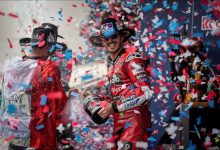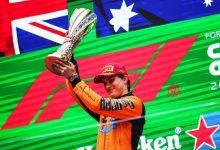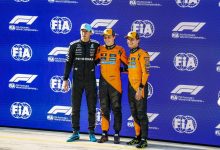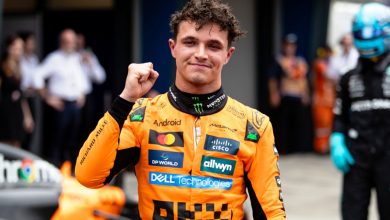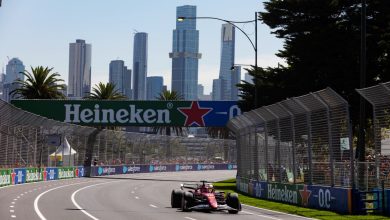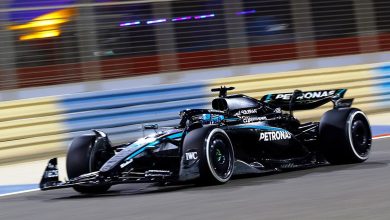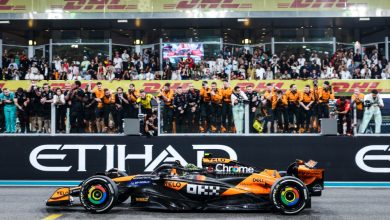Team leaders talk on Friday: Austrian GP
TEAM REPRESENTATIVES – Graham WATSON (Toro Rosso), Beat ZEHNDER (Sauber), Luca FURBATTO (Manor), Rob SMEDLEY (Williams), Paul MONAGHAN (Red Bull Racing), Yusuke HASEGAWA (Honda)
PRESS CONFERENCE
Rob, if we could start with you, an unusual kind of day: a very fast morning session, record lap times, but then the early part of the afternoon affected by rain. How much do you feel you were able to learn today and what does the rest of the weekend have in store for us?
Rob SMEDLEY: Well, you never learn as much as you want to, even in the dry. So when you’ve got the session interrupted by rain like we had, right in the middle of the session, then you learn even less. I think we got out of it what we could have done in the circumstances. There are quite a lot unknowns going into Sunday in particularly. In terms of qualifying learning, as long as it’s dry tomorrow morning then we’re fine in terms of what we need to know for that. In terms of the race there are going to be unknowns but it’s the same for everybody. It’s a case of tracking where the asphalt is going, the rubber/tarmac interaction that will be evolving over the weekend and ensuring that we’re on top of it.
It’s been quite a turnaround; Williams have become Formula One’s pacesetters in terms of pit stops, recording the fastest stops of any team at the first few races of this season. That’s quite a big change from the last couple of years, how’s it been achieved?
RS: Hard work. A lot of hard work. A really good collaborative effort I would say from everybody, right across the groups, from everybody who is involved with the pit stop performance, identifying where the weak areas were, then looking at detail design. We haven’t changed anything fundamentally but we have certainly been through a lot of subtle detail to get around the Achilles heel of last year and the year before. And then really good work within the race team itself, in terms of how we co-ordinate ourselves, how much practice we do, the type of practice we do, making that relevant to a Sunday afternoon.
What was the Achilles heel – wheel nuts, front jack?
RS: It’s fairly clear. It’s not a secret. You can watch the television and know why we were so slow. We couldn’t get the wheels off. We were taking one-and-a-half to two-and-a-half times longer than anybody else to get the wheels off in the stop. It’s been a really, really good effort in particular by the suspension design group to design our way out of that. I think it’s been absolutely fantastic and you’ve seen the results: it doesn’t hamper us anymore, it leaves us many more strategies, and a lot more tactics are open to us on Sunday afternoon, whereas they weren’t in 2014 and 2015. I think a lot of people don’t realise that it’s a one second loss in a pit stop but that has huge ramifications for your strategy and tactics.
Thanks for that. Paul, coming to you, obviously Baku was a little bit of an outlier as far as you’re concerned with a lot of problems with the tyres and heavy degradation. Has that been sorted and have you got an explanation for us today?
Paul MONAGHAN: We’ve developed some theories and they stand scrutiny within our own analysis. The proof of the pudding of course is that we don’t repeat it, and we have no intentions of doing so. As is often the case when something goes wrong, it’s a cascade of events that occur in sequence and each one actually happens. So a number of things went wrong. I think we triggered the degradation ourselves and if our theories hold tight we won’t do it again.
Is that by running lower downforce?
PM: No, not in isolation. It’s a whole number of things that come together, as I would expect anybody else would offer you. It’s not one thing that’s going to cause a tyre to do that. Don’t forget that we started with a pretty hot track; we finished the race with a cooler track. So many things changed through the race that weren’t even associated with the car, so I think we know what happened and we won’t do it again don’t worry.
Now, yesterday here, Daniel Ricciardo confirmed he’s committing his future to the team, as has Max Verstappen. What difference does it make to you and the engineering group to know that you have got the same drivers for a period of years now in terms of development, design etc, and is Daniel right in saying that he feels your team is building for a challenge for next year’s world championship.
PM: It’s great to have the two of them signed. I think the way Daniel has been driving this year is amazing. Obviously Max has arrived and caused quite a stir and he’s clearly going to be one to watch. In terms of setting the design of the car, clearly it means we know what we’re packaging around. We’ve got them both in this year’s car, so looking forward to 2017 it’s one less challenge to deal with. In terms of their feedback, they are both very good, so it’s not as if we lack anything in terms of driver feedback. They are both articulate, they’re both knowledgeable and their feedback is valid and relevant. It’s not as if they comment on subsets that have little effect on the car. We know that we have two that are good at it. It’s settling as opposed to facing an unknown, I’ll take that every day.
Thanks for that Paul. Luca, Manor are still looking for the first point but you’ve had at least one Sauber behind you on the grid at the last three grands prix, so are you beginning to get to where you want to?
Luca FURBATTO: Yes, I think the answer is yes. From memory we out-qualified both Renaults in Baku, both Saubers in Canada, very close to Q2 in the last two events. Everybody has been working very hard. We’ve got a development plan for the rest of the season. We have new parts here in Austria, we’ll have new parts in Silverstone and as I say, we’re pushing very hard. We want to convert the performance gain in qualifying also into race gains.
You mention developing the car still. How much pressure does it put on a small team like yours to have to come up with a car to a completely new set of regulations such as for 2017 and what expectations do you have for next year?
LF: I think the regulation change is a massive one for everyone and obviously it’s a tough one for a small team. Every team is dealing with pressure. Every team will have its own pressure. We had a lot of pressure in 2015. We had to rebuild the team; we had the late signing of a new power unit. I think last year we did an amazing job to turn up on time with a new car that was significantly quicker than the last year. We have pretty much doubled in size and I’m very optimistic that we can do a very good job for next year as well.
Hasegawa-san, turning to you, the new turbo seems to have helped at the last couple of races. How far would you say you are off now being able to extract the maximum from the power unit and can you confirm that this current power unit design is the right one now and you won’t need to do a redesign for 2017?
Yusuke HASEGAWA: Regarding the turbo, we introduced a new turbo in Canada. Of course we are never satisfied with the performance, there is always room to improve. Regarding an ERS system point of view, we have some limitations in the regulations, the maximum power is 120 Kw and also the energy is limited, so from that point of view I think we have achieved almost a decent, satisfying level from the turbine. Last year here the power was cut off in half of the straight, so it was a disaster last year. So from that point of view we are proud of that. But on the other hand, the internal combustion point of view still we need to improve the engine performance and we are currently trying the very hard job to redesign, not redesign but to improve the engine for next year, so that is ongoing.
So it’s not a redesign for 2017?
YH: Not completely redesigned. Of course there are a lot of places we need to redesign.
So tell us what is the development plan for the next few months and the rest of the year?
YH: We are hopeful that we can introduce some of the upgrades in a couple of races. I have already confirmed we see some good elements, so as soon as we are ready we will introduce it.
Graham, coming to you, Toro Rosso retaining Carlos Sainz for another year, which will be his third year. It’s quite unusual for the team to do that with a young driver. What’s the thinking about holding on to him at this stage?
Graham WATSON: Yeah, you’re right, generally over the last couple of years we’ve had a fairly fluid driver line-up, so to have Carlos at the team for a third year is fantastic for us. Obviously Red Bull are the people who hold the contracts for the drivers, so we pretty much live with what they like us to use. We are very happy to have Carlos, he’s a very quick driver, very focused. He’s got a strong desire to be a world champion in the future, so that’s his big drive. For a team, continuity breeds good results and to have him for a third year allows us to build on what we’ve been building on for the last season and this season and hopefully we can deliver some of the targets we’ve been setting ourselves with his experience backing him up.
Picking up on what we discussed earlier on with Rob Smedley, pit stops are occasionally a problem for Toro Rosso. Are you looking to make a Williams-style improvement for next season?
GW: Yeah, pit stops are a constant irritation. We’re probably somewhere where Williams were and listening to Rob we probably have got a very similar problem of getting the wheel off fast enough and back on generally. We are obviously looking at all areas of the car for 2017 with the new regulations but clearly we have a big focus on trying to improve the situation with pit stops, giving the guys the equipment they need to achieve what are now fairly phenomenal pit stops from Williams and Ferrari. We are on average about a second behind and as Rob says that has a massive impact on strategy and how you can call your race as you go.
Q: Beat, coming to you, Felipe Nasr was here yesterday and said there is a much more positive atmosphere around the team, salaries have been paid, tell us what’s changed, and what the outlook is like.
Beat ZEHNDER: Paying salaries definitely helps for the atmosphere in the team! Paying the salaries, the outstanding salaries, is part of a comprehensive solution we were still working on but for any details you have to ask Monisha. Obviously there is a change in atmosphere because now everyone believes again that there is a future. The crucial thing so far was not to give up and I think we can be very proud of our team here on the track and at home that kept on pushing in our very limited areas. There was always light at the end of the tunnel – but as you know Switzerland has just opened the longest railway tunnel in the world – the light was always there, the tunnel was just massively long. The tunnel is getting shorter now.
Q: Obviously you do a whole bunch of different roles at the team. In such circumstances how difficult is it to keep the team all together, to hold on to your key people and just keep everybody moving forwards?
BZ: It’s not always easy, it’s for sure easier on the track because everyone who is here loves to do what they are doing, they love racing and so the motivation part on the race track is a simpler one than back home in the office. For the technical department, for the design office, sometimes it is quite frustrating, knowing you have things in the pipeline but you cannot bring it to the track because of financial reasons. But, as I say, there should be a brighter future.
QUESTIONS FROM THE FLOOR
Q (Peter Farkas – Auto Motor) We understand there is a new protocol regarding tyre pressures from this weekend. What’s your view on that? Does it make any sense? Is it a step in the right direction? Will it change anything at all?
PM: Accepting that I have some competitors in the room, it’s… I suppose if you’re presented with a set of regulations, it’s for the competitor to demonstrate compliance, so in this circumstance we’ll demonstrate compliance. It makes our life a little bit easier; it changes the challenge a small amount but at the end of the day we’re judged relative to our competitors, therefore we’ll observe the technical directive and it’s then up to us to extract the most out of the package for the rest of the weekend. In amongst everything else that can change on the car – and you saw in P2 a slight interruption from the weather – it’s something that we’ll take in our stride and deal with.
Rob, from a Williams point of view, anything to add?
RS: I think that I pretty much agree with what Paul said. It’s up to us to adhere to it. It’s a technical directive. I don’t think that it’s going to offer a great deal in terms of any great differences to what people are doing now. Possibly in practice it changes things a little bit but I really don’t see it as being particularly significant.
BZ: If the result of the new procedures are lowering the starting pressure then we are very happy with it.
GW: Same
LF: Just a little bit easier operationally, particularly for the free practices but, as the others said, not a big difference.
Q: (Christian Nimmervoll – motorsport-total.com) Question to all of you about Brexit. Can you talk about the implications for your team economically? Because there are different countries represented here. It would be interesting to get the opinions.
BZ: I can give you some guidelines on working with customs papers if you are not belonging to the EU!
What about the teams based in the UK first of all. Rob?
RS: I don’t know. It’s too early to say, isn’t it. When you’ve got the two leading parties slightly in turmoil and we haven’t decided what to do yet, the people of Great Britain voted, they took a decision. If democracy stands then we’ve got to stand by that decision and it’s up to the politicians really. It’s not going to be something that will be solved in the short-term. I think it’s probably going to run on and there’s going to be lots of smaller, down to almost-insignificant elements that are still going to need sorting out and organizing still in years to come. As far as the impact on Formula One is concerned, I’m sure everybody here would join in by saying that hopefully it’s negligible. Whether it will be, whether it changes the way we travel or who we’re allowed to employ, I don’t know, let’s see. I’m sure in the short term there’s not going to be anything significant.
How about you Luca, as an Italian working in England, any concern there?
LF: I’m not an expert on the subject, I never cracked the Italian politics, let alone the British ones, so unfortunately I think it’s a bit too early to say.
Paul, presumably all the staff that you employ, the ones who come from Europe, you can argue they’re highly specialized, I guess that would help in the future.
PM: I don’t think we know at the moment. To answer the gentleman’s question, in the short term it’s had no impact on us. As Rob said, we await the long-term impact and I’m sure everybody will face the same guidelines and interpretations of it and we’ll comply as a company, obviously, and we’ll seek to strengthen and hold our position within the sport, whatever that incurs.
Hasagawa-san, obviously Honda investing in the UK – any concerns there?
YH: Actually I’m not in a position to actively join this conversation. I hope the UK people will manage this situation smartly. I respect every decision you made, I think.
Q: (Peter Farkas – Auto Motor) To Paul but also all of you: we saw what happened to Max with those Abu Dhabi kerbs. They have been installed at several corners. Are you comfortable with those or do you want to have a change?
PM: Comfortable? No. Our car didn’t ride them terribly well and I personally think it would be a shame if other cars incurred similar problems so how that’s resolved I don’t know. That’s hopefully for later today. In terms of the integrity of the car, I have no concerns with the integrity of it. We’re quite happy to field it. Daniel continued to run. If they’re there, we will miss them.
BZ: No thoughts, really. I’m waiting for five o’ clock, the drivers’ briefing. I’m pretty sure drivers will have something to say. Pretty sure drivers are not too happy but they’re… normally the kerbs are there for a reason so Charlie would normally say ‘just don’t go there.’
Q: That’s what you expect the outcome to be, is it?
BZ: Yeah. Maybe we’re going to remove one or two.
GW: Same as Beat really. I’m sure at five o’ clock it will be a hot topic to be discussed so we will wait and see how the drivers and Charlie get on about it.
LF: Yeah, we went over a couple of them in FP1 and 2. We didn’t have any problems but I’m sure they will be discussed with Charlie and the drivers.
Q: (Peter Farkas – Auto Motor) Regarding the radio rules, we always hear many complaints from the drivers that the cars are too complicated to operate but actually Felipe told us yesterday that it was the task of the engineers to make the cars as easy to operate as possible so the drivers don’t have a problem with it as Lewis did in Baku. Do you agree with that? Is it possible to make the cars easier to operate, so they don’t have to bother with the switches so much, and is it possible to implement a kind of audio guide into the car which tells them which switch is doing what? It seems to be logical from the outside.
RS: Well, to answer the part about the audio guide then no, that’s not possible for various reasons. And to a certain extent he’s right, Felipe’s right when he says that it is up to the engineers to make the cars as simple as possible, not only to drive but to operate as well. That’s something that we’re always very keen on pushing, that ethic if you like, at Williams. I think there’s lots of times that we have an idea but the complexity of that idea when you turn it into reality far outweighs any benefit you can get from it, and I think trying to simplify… it’s the job of an engineer really to be able to chose systems or methods that keep you on the peak of simplicity and performance. So yeah, to a certain extent I definitely agree with him that it’s up to us. What happens in other teams, I can’t really tell you. The regulation as it stands at the minute we adhere to it, we comply with it. It makes our lives a little bit more difficult at times, especially when there’s more critical messages to pass but it’s the same for everybody. Again, it’s one of those things that people talk about a lot and apart from with Mercedes last Sunday afternoon, it doesn’t really make a big difference.
Q: These power units are very complex, Hasegawa-san. Do you try and make it as simple as possible for the drivers to operate and manage?
YH: Yeah. The issue is that the regulation is to ambiguous. I don’t know what is banned and what is OK so sometimes – like in Baku – we had the oil temperature was very hot so can we tell the driver that the temperature was very hot? Even that is… so we evade the issue. With some regulation we can tell that but some of the engineers say that it is not OK. It is very complex and I would like to understand; does it make the race really exciting or..?
Q: (Christian Nimmervoll – MotorsportTotal.com) You have all approached a period where you are starting work on the 2017 cars and I’m sure most of you have progressed a lot already. Particularly for the smaller teams, there’s going to be a point in time very soon where you will have to stop working on the 2016 to manage your resources. Can you tell us what updates you have planned for the rest of the season and when is that point coming when you are going to completely stop working on the 2016 car?
GW: We clearly see 2017 as a big challenge and 2016 is obviously still very important because we have our lofty height of trying to be fifth in the championship which is an aggressive target and probably quite tough to achieve but we don’t want to give up on that so I’m sure that there are some upgrades coming for the future over the next two or three events. But the focus in terms of 2017 has already moved towards that car and has been for a little while now so what we are going to bring to the track over the next few events is already being developed and designed and put in the pipeline. So in terms of your question, I suppose yes, 2016… we’re nearly there and 2017 is in full flight.
BZ: Yeah, same for us. We have some bits and pieces coming for Silverstone and then Hockenheim possibly but then the concentration is fully on 2017. We still have the aim to be in front of the Manors and possibly beat the Renaults but realistically, we have to concentrate, as a small team, fully for 2017.
LF: As I mentioned, we have upgrades here and we’re going to have one in Silverstone, Hungary and Belgium and Monza so we’re still pushing for the 2016 car, obviously, but most of the guys here, a small team that started a few months ago on the 2017 car and it’s just a progressive transition during the season, and more and more people will shift to the 2017 project. For a small team like us, obviously we can’t start to think about 2018. Some of the top teams have already started looking a year in advance, ahead of 2017 but we have started and that’s the important point.
RS: Yeah, I probably touch more on what Luca just mentioned really. I think that the focus of the front-running teams now has already switched to ’17. There’s certainly updates coming for us. We’ve got updates coming for every race from now almost until Singapore but they were already programmed, they were all ready to come on line. It’s really a case of… the focus isn’t between ’16 and ’17, it’s between ’17 and ’18 because there’s certain things that we are already thinking about for… that we would put in towards the back end of ’17, the middle of ’17 let’s say, and even ’18. I think the focus is slightly different now. We were answering the ‘16/’17 question in Australia and Bahrain. We’ve possibly moved on a bit.
PM: In essence, I would echo that. Part of our team is ’17, part of it will still look at ’16. I would imagine that every representative in the pit lane will have some sort of revision for some circuits. If you take Monza, for example, I bet everybody turns up with skinny wings so it’s not as though we can ignore ’16 and that’s true of everybody. The amount of effort we put in will be determined by our aims, progress, wishes, ultimately our own judgement.
eom/FIA transcript of the press conference
